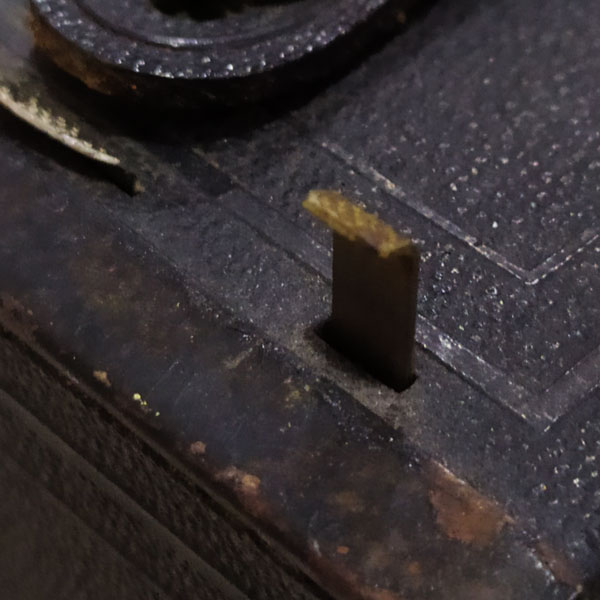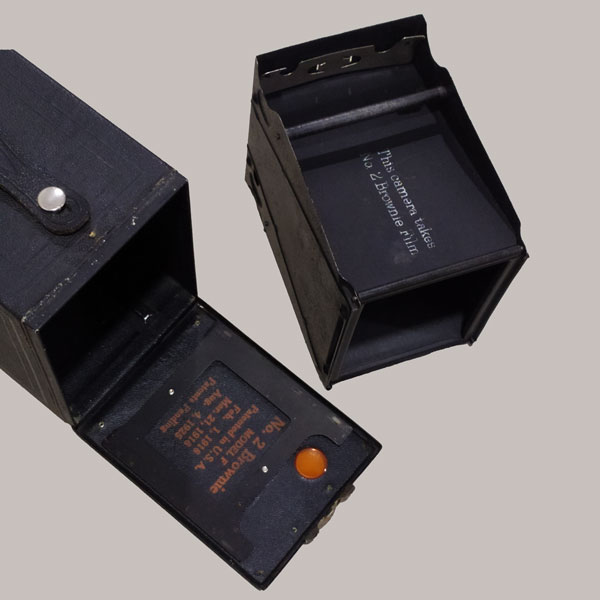 Kodak Brownie No.2 Model F Sample Photo Digital Scan Negative Contact
Kodak Brownie No.2 Model F Sample Photo Digital Scan Negative Contact
After Kodak had success with the Kodak Brownie No.1 camera, which came with film loaded with 100 pictures, with the campaign "You Press the Button, We Do the Rest" - meaning the photographer just had to press the shutter button and send it to the company to develop and print the pictures, and send it back with the camera loaded with new film - Kodak released a new model of camera that was just as easy to use, with some additional functions - and the user could change the film and develop it themselves. This was the second model.
This Kodak Brownie No.2 box camera was first used around 1901-1935. There were 6 models in total: Model A - Model E. It was the first camera to use 120 roll film. The camera shown here is the Model F ...
Kodak Brownie No.2 Model F Produced in 1924, towards the end of the Model A-E's production cycle, the camera was still made of cardboard, but the Model F had a metal case, making it more durable. It had both a vertical and horizontal viewfinder, and two pull-out tabs at the top.
 Kodak Brownie No2 Model F Viewfinder
Kodak Brownie No2 Model F Viewfinder
The viewfinder can be viewed both vertically and horizontally.
 Kodak Brownie No2 Model F Top
Kodak Brownie No2 Model F Top
The top lever to the left from the picture (large) is the aperture change lever.
The right (small) is the shutter speed change lever between 1/50 sec. and Time.
Use by holding and pulling up.
 Kodak Brownie No2 Model F Shutter Lever
Kodak Brownie No2 Model F Shutter Lever
Shutter speed lever between approximately 1/50 and Time
Pull up the lever to use the time shutter.
 The shutter release is located on the right side of the camera near the front.
The shutter release is located on the right side of the camera near the front.
Shutter Release: Press Up or Down in both directions.
Shutter 1/50 seconds Press once Up or Down, do not press again, it will be a double image.
Time Shutter: Press once to open the shutter curtain, press once again to close the shutter curtain.



Pull up the aperture lever one step at a time.
Another lever can be pulled to change the aperture to three types: f/11, f/22 and f/32.
The lens is a Meniscus type with a focal length of 100mm and a minimum focus distance of 3 meters or 10 feet.
Using 120 film, you will get 8 photos of approximately 6x9 cm.



The back cover lock and back cover are embossed with various details and indicate that it can be used with 120 film.
Open the back cover and turn and pull out the film spool control dial before pulling out the film loader.


Open the back cover and pull out the film loader
Photography in those days, before cameras used roll film, most cameras used wet plate or dry plate and had many adjustment functions, such as shutter speed, aperture, etc. Professional-grade cameras were expensive due to the difficulty of production. There were many tools required to develop the film and print the photos, so the costs were high. It was difficult for ordinary people to take photos by themselves.
Kodak’s idea at that time was to produce a camera for the general public. They could buy a camera and use it easily without having to set up much. They could develop the film themselves and print the photos themselves easily. The easiest way to print photos was to use contact printing, which allowed them to see the photos they wanted without using any enlargement equipment. This led to the production of this camera at an affordable price. It was a camera suitable for the general public who had never studied, trained, or had any knowledge of photography before. It was easy to use and became widely popular. When the public could take photos and print their own photos, in addition to the income from selling the camera, the film, photo paper, and various chemicals also greatly increased Kodak’s income.
For using a camera like this today, it may not be convenient and cannot take pictures in all lighting conditions as desired as many new cameras because the shutter speed has only one value, which is 1/50 second (and it is not fixed, depending on the age of use). There are only 3 aperture values to choose from: f/11, f/22 and f/32. If we compare it to EV with ISO 100 film, shutter speed 1/50 sec. and lens length 100mm, the values obtained are as follows:

f/11 = 13 EV Cloudy bright

f/22 = 15 EV Sunlight (Sunny 16)

f/32 = 16 EV Sunlight + snow
If compared to the Sunny 16 rule, it will be around 15 EV (ISO100 : 1/100 : f/16)
This means that this camera must take pictures at least in the shade with sunlight, and in very bright sunlight to get good pictures. Indoors or in a room, you must use a Time mode. Kodak itself recommends taking pictures with a box camera like this "2 hours after sunrise and 2 hours before sunset" (around 9 am to 4 pm) to get good pictures. And a slow shutter speed of 1/50 sec. with a lens focal length of 100 mm. (meaning the distance from the lens to the film plane), if you don't hold it still, the camera will shake, and the picture will be blurred for sure. Therefore, this camera has a tripod mount or a screw hole for attaching a tripod base.
Another observation, 100mm lens with 6x9mm film has a small depth of field. I think it is made for taking pictures of people or objects. It is not suitable for taking pictures of landscapes that require sharpness and high depth of field.
f11 = 3-3.5 feet (focus at 3.2 feet)
f22 = 3-4 feet (focus at 3.4 feet)
f32 = 3-4.5 feet (focus at 3.6 feet)
**This distance is not certain whether it is correct or not because I haven't checked it yet.**
Sample images from the camera
Kodak Brownie No. 2 Model F
Kentmere Pan 100 film
Shot in the shade in front of a building with sunlight, it looks good. The last picture in the sunlight is also good. As for sharpness, I think it should be a bit more than 3 feet, 3.5-4.5 feet is OK.
 This photo was taken on the stairs in front of the building. The light was reflecting in at a good distance of about 4 feet.
This photo was taken on the stairs in front of the building. The light was reflecting in at a good distance of about 4 feet.
 This picture is a little closer, so it's a little blurry.
This picture is a little closer, so it's a little blurry.
 Come out of the building, out of the shade, into the bright sunlight, you can take pictures easily.
Come out of the building, out of the shade, into the bright sunlight, you can take pictures easily.
Nowadays, we may be accustomed to or want a camera that can take pictures according to our wishes. If we try taking pictures according to the wishes of the camera, it might be fun.
Specifications : Kodak Brownie No. 2 Model F
Made in the USA
Film: Uses 120 roll film
Lens: 10 cm meniscus lens
Apertures: F11, f/22, and f/32
Shutter speed: 1/50
Minimum focus distance: 3 meters (10 feet)
Weight: 500 grams
Body: Metal covered in leatherette
Viewfinders: Two, one for portrait and one for landscape
Tripod mount: Yes
Bulb mode: Yes
Size: 5.5 in x 3 in x 4 in



Comments powered by CComment